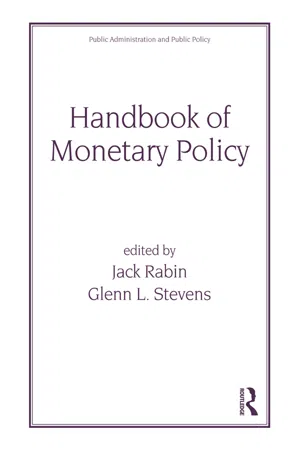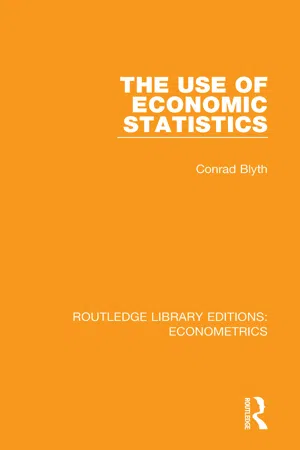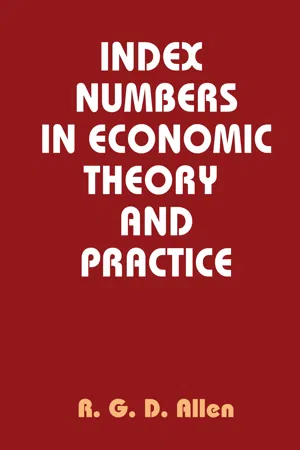Consumer Price Index
The Consumer Price Index (CPI) is a measure of the average change over time in the prices paid by urban consumers for a market basket of consumer goods and services. It is used to gauge inflation and to adjust income and cost-of-living increases for individuals. The CPI is a key indicator of economic health and is closely monitored by policymakers and economists.
6 Key excerpts on "Consumer Price Index"
- eBook - ePub
Economic Indicators for Professionals
Putting the Statistics into Perspective
- Charles Steindel(Author)
- 2018(Publication Date)
- Routledge(Publisher)
...This suggests that the PPI could provide an effective guide to aggregate GDP price measures, at least in the business sector. Since the PPI is a monthly index, it might provide an unusually valuable guide to emerging developments in broad GDP price measures. CPI The CPI is surely the best-known measure of aggregate prices, used for a wide variety of purposes. It is typically released by BLS at 8:30 a.m. Eastern time soon after the release of the PPI, though there have been times the CPI for a month has been released prior to the PPI. The CPI is an index measuring the prices consumers pay for a fixed basket of goods and services: the current level of the index measures the growth of these costs since the basket was introduced. Thus, the CPI is considered to be a Laspeyres price index. The components of the basket are derived from the regular Consumer Expenditure Survey conducted by Census for BLS. 4 The basket is updated periodically, but there are no retroactive revisions to the estimates of the growth of the CPI in the past. CPI technicalities There are numerous technical points connected to the construction of the CPI which have been the subject of ongoing discussion and analysis, and impact the usual interpretation of the index as a measure of the cost of living (the BLS 123 Handbook of Methods 5 describes in detail how the CPI and the Bureau’s other indexes are constructed). Five of the most important considerations are listed below. 1. The pricing of a fixed basket of goods and services means that ongoing shifts in the pattern of consumer spending are not taken into account in computing the CPI. In general, the CPI will tend to overstate growth in what economists see as the growth in the genuine cost of living, which is the increase in income needed to maintain the prior period’s level of consumer satisfaction. Consumers will partly offset the blow to their cost of living from a price increase on one product by switching their purchases to other items...
- eBook - ePub
The Rise and Rise of Indicators
Their History and Geography
- Stephen Morse(Author)
- 2019(Publication Date)
- Routledge(Publisher)
...2 Economic indices Introduction It is probably true that there are more indicators that revolve around money than any other area of human endeavour. I say ‘probably’ because one only has to look at the news each day to read about economic growth (or not, as the case may be), how businesses are doing, household income, house prices, inflation and so on. Almost all these stories include accompanying indicators by which the journalists and those being interviewed seek to tell us how well, or badly, matters are progressing. It can be bewildering to see how all of them use these measures to make their case and dismiss the case made by their opponents, who in turn seem to use much the same indicators to spin a completely different picture. The head can swim as you hear that the country is doing very well – ‘just look at indicator 1, indicator 2, etc.’ – only to be told by the next person who appears in front of us that the ‘country is in the doldrums as shown by indicator 3, indicator 4, etc.’ what makes it worse is that the same ‘thing’ seems to have a number of indicators. In the UK, for example, we have two ‘headline’ indices of inflation: Consumer Price Index (CPI for short) Retail Price Index (RPI for short) Both of them measure the change in prices of a ‘basket’ of goods and services over a period of time, and the index is expressed as a percentage: either a percentage increase or decrease. If inflation is positive (i.e. greater than zero) then the purchase power of money declines over time, meaning a pound buys less and less as its value declines. The CPI and RPI are, in essence, the averages of the change in price of the items in the basket, although part of this may well include an element of weighting to allow for the fact that a household may routinely purchase more of some goods (foods such as bread, for example) and services (such as water and power) than others (such as electronic goods)...
- eBook - ePub
The Retail Prices Index
A Short History
- Jeff Ralph, Robert O'Neill, Paul A. Smith(Authors)
- 2020(Publication Date)
- Palgrave Pivot(Publisher)
...The oil price is an important economic indicator and changes are reported in the press along with their implications for motorists. Consumers who buy petrol or diesel regularly will be aware of the resulting price changes. For other items such as bread and milk, prices are usually more stable over time and changes are not so apparent or newsworthy. Although the common perception is that, overall, prices go up, we as individual consumers cannot see the whole picture extending over the huge range of consumer goods and services on offer in the marketplace. A robust statistical treatment is the only way of knowing if, overall, prices are rising or falling. The Retail Prices Index (RPI) is one of a family of statistical measures that attempts to address this question. It is constructed by taking a basket of goods and services carefully chosen to represent the full extent of the products and services available for consumers to buy and tracking prices of the component items. Each month, prices of these representative items are captured across the UK in different types of store and from the internet. The proportions of expenditure on different types of consumer item are also measured, though less frequently, primarily through a household survey. The average price change from a given reference period (usually a calendar month) is calculated by adding together the prices changes of the representative items weighted by the proportion of household expenditure they, and the items they represent, take up. The Retail Prices Index has been calculated on a monthly basis since January 1956 and shows how prices have changed each month from a reference period where the index value is set to 100. The original reference period was January 1956; it is revised from time to time with the current reference period being January 1987...
- eBook - ePub
- Jack Rabin, Jack Rabin(Authors)
- 2020(Publication Date)
- Routledge(Publisher)
...We find that the ECI and the core CPI (which excludes the often volatile food and energy components) frequently move in tandem, with only a slight tendency for labor cost developments to precede price movements (Figure 1). Figure 1 Labor costs and core inflation (four-quarter changes). These mixed findings suggest that a disaggregated approach to explaining CPI inflation would be fruitful. We break down the CPI into various components in order to isolate those goods or services whose prices are most likely to respond to changes in labor costs. In theory, one would expect labor costs to have the strongest direct impact on prices when these costs represent a substantial portion of the cost of production and when producers have some control over the setting of prices. Thus, we look for categories of goods or services that meet both of these criteria. We find that factors other than labor costs dominate price determination for many of the CPT’s components. In fact, these components (identified as “other expenditure categories” in Table 1) represent a significant share of consumer spending. For example, prices of energy and food eaten at home, which together make up about 17 percent of the CPI, often fluctuate because of weather conditions, international political developments, or other temporary factors unrelated to producers’ labor costs. Housing costs, which account for about 26 percent of the CPI, are also little affected by current labor costs, because the short-run supply of housing is essentially fixed, with rents determined much more by land values and the cost of materials than by the labor input into current housing services. 2 Moreover, in the case of several components of the CPI, the government plays a major role in setting prices, so even if labor costs were an important part of production we would not expect them to affect prices directly...
- eBook - ePub
- C. A. Blyth(Author)
- 2018(Publication Date)
- Routledge(Publisher)
...It gives a rough indicator of the movement in retail prices. Remember that if expenditure patterns have altered considerably, or if the kinds of goods and services bought differ substantially, then the measurement of average price changes becomes merely a piece of arithmetic without economic significance. We interpret the figure of 70 per cent increase estimated in the previous paragraph to mean not that the cost of living has increased by 70 per cent—rationing and the unavailability of goods in the early part of the period mean that expenditure patterns have changed considerably over the twelve year period—but simply that the typical increase in retail prices has been of the order of 70 per cent. (b) Index of Market Prices of Goods and Services. This is an index calculated by the Central Statistical Office in connection with their estimates of national income and expenditure (see Chapter 4). The index is of the variable weight type described above (section 4): each time the index is calculated the weights are those based on the prevailing basket of goods and services purchased. These weights refer to the expenditure of all consumers on all goods and services, i.e. they represent the average expenditure pattern of all classes of households. The index for all goods and services—Total consumers' expenditure' —and for the major classes is published in ΝΙΕ. In 1957 ΝΙΕ, Table 21, there are annual index numbers for 1938 and for 1946-56 with 1948=100. In 1959 ΝΙΕ, Table 20, there are index numbers for 1948-58 with 1954=100. The strict interpretation of the index is as follows: according to Table 20 of the 1959 ΝΙΕ the index of market prices of total consumers' expenditure in 1957 was 111 (1954=100). This means that between 1954 and 1957 the cost of all the goods and services bought by consumers in 1957 increased by 11 per cent. The same type of statement applies to the index number for any other year with reference to the basket of goods bought in that year...
- eBook - ePub
- R. G. D. Allen(Author)
- 2017(Publication Date)
- Routledge(Publisher)
...Such a decision is needed, for example, when a cost-of-living clause is inserted in a contract or a sliding-scale for wages. The present application aims at getting a general-purpose deflator for use in the middling run, specifically from 1948 to the early 1970s. Two different index runs are available as candidates for selection: the Consumer Price Index of the national income accounts (or the consumers’ expenditure deflator, to use its most recent label), and the retail price index of the Department of Employment. The index of retail price is strongest in short-run applications and it is, indeed, the only one available monthly. The Consumer Price Index can be estimated quarterly but is essentially an annual construction and its strength lies in comparisons over a period of several years. As the general deflator sought, the retail price index is good in the short run since 1962 but over longer periods the Consumer Price Index seems to have it. The reasons for the preferences are easily elaborated. The base year of the Consumer Price Index is changed fairly regularly, as it must be if the index is to continue, and currently at about five-yearly intervals. A critical point is how the index runs are to be chained to provide a run over longer periods. The index on a particular base is calculated forwards as a Paasche form, implied by the corresponding Laspeyres index of real consumption; but it is also carried back to the previous base year making it possible to get both a Laspeyres and a Paasche index in the link from one base to the next. There are objections (5.7) to a Laspeyres index which tends to run high, to a Paasche form running low and to a run based on a year in the middle as switching from divergence one way to divergence the other way...





